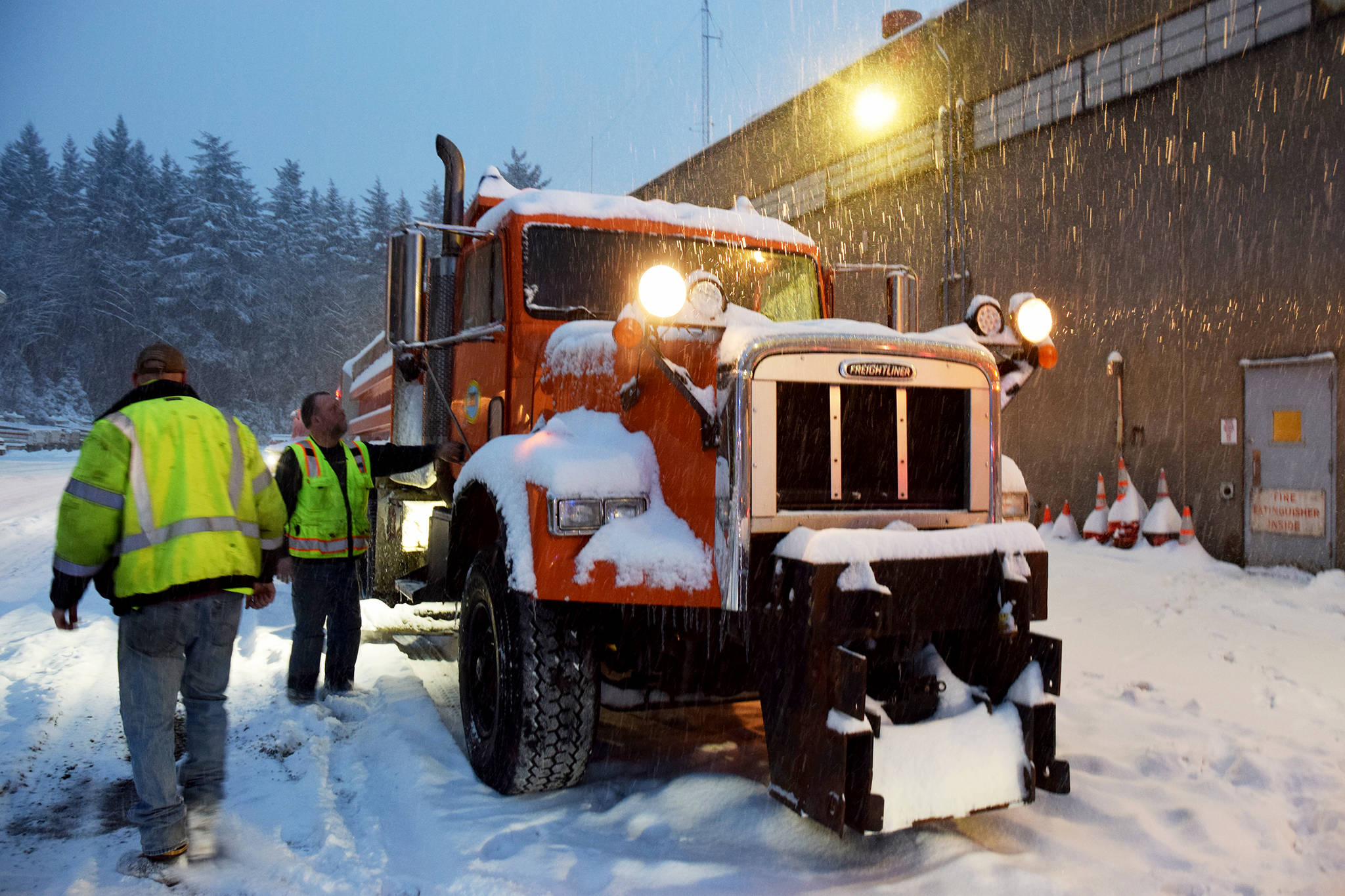There’s 180 miles of road line in the City and Borough of Juneau. After a big winter storm, that’s a lot of snow to plow.
It begs the question: which roads get plowed first?
“[The first ones cleared] are “priority one” roads,” said Aurah Landau, public information officer for the Alaska Department of Transportation & Public Facilities. “These are the essential transportation corridors.”
In an effort to make sure the roads most people use are the ones that get plowed, DOT&PF raised Back Loop Road and Mendenhall Loop Road to the highest level of priority. This means more plows and quicker plowing in those areas. Before this winter, only Egan Drive was a “priority one” level road, said Landau.
“These roads are ones that are essential for large numbers of people moving in and out of an area,” she said. “This means they are cleared first, more often and the window in which we commit to cleaning them is the shortest (12 hours).”
State budget cuts have affected the DOT&PF. But when winter storms like the one that began Thursday night happens, Landau said they throw all the staff and resources that they have into clearing the roads.
In Juneau, the DOT&PF currently has four snow plows, one tow plow, two graters and various other trucks to follow the plows and clear sidewalks. They have 14 people in the department and stagger shifts so there’s always about eight people working. CBJ also has its own set of plows that they use to clear city-owned roads.
From fiscal year 2015 to 2019, DOT&PF budgets declined by $35.7 million across the state. Since fiscal year 2011, there were 544 positions cut statewide in the DOT&PF. 63 of them were equipment operators, 14 which were from the Southcoast region. This fiscal year, maintenance budgets remained stable.
The art of the tow plow
Before snow began to fall Thursday afternoon, Spencer Gates started plowing at 4 a.m. that day in anticipation of the storm. He works as an equipment operator for the DOT&PF, and helps plow roads during storms
[Juneau schools get first snow day since 2011]
First he drove the main priority roads of Egan Drive and Mendenhall Loop Road. Then out the road to clear snow for the buses shuttling workers to Kensington Mine. He said he sees lots of deer and even some wolf tracks.
“In the morning it’s really peaceful,” he said.
That early in the day, it’s easier to plow because there’s not as many cars on the road or people walking on the sidewalks. For the past three years, he’s the only person in the department who has driven the tow plow, which is twice as big as a normal snow plow and covers two lanes at once. It has a 26-foot long blade on the right side which the driver can swing out using a hydraulic system.
“It takes a lot of concentration to operate, because you have no reference point,” Gates said. “You have to try to anticipate the other drivers on the road.”
Thursday was the first time he’s ever let someone from the media ride along in the tow plow.
“This is the fourth year they’ve wanted someone to ride along with me,” he said. “But I always said absolutely not. There’s too much to concentrate on.”
Just before rush hour on Thursday, they were doing what they call “gang plowing.” A regular plow drives in front on the left-most side of the lanes to clear the center line and alert the following plows for other cars and possible pedestrians or animals on the side of the road. The tow plow follows second doing most of the plowing, and two other trucks flay out towards the right side of the road behind that to do the fine tuning along the curb.
If there’s someone on the side of the road, the tow plow driver has to swing the blade in and lift the belly blade, which flings out snow several feet to the side.
[Airport celebrating snow removal equipment building]
A wake of snow flowed from the blades as he extended the tow plow and began to drive along Egan Drive. It felt like being on a giant ship in a sea of snow: the heat on high so the windshield wipers wouldn’t freeze, the windows rolled down so he could see the mirrors better and control the temperature.
The radio crackled to life: “You’ve got to be kidding me,” a voice said. “That car’s got its blinker on trying to get in the right lane behind the belly blade of the tow plow.”
Gates slowed down and moved into the left turn lane to clear snow as the car zoomed past on the right.
“Some of these cars wouldn’t drive so fast if they knew how bad the roads looked just a few hours ago,” he said.
Gates said he’s never hit anyone with snow driving the tow plow.
“It’s one of those things you pride yourself on,” he said. “It’s important to me because I’ve got my own kids out on these roads. As a father of five, that’s a good gauge for how much attention you pay to the roads.”
Landau urges drivers to be patient and drive carefully, because it can still take some time to plow all the snow that is forecasted.
“We can’t get to everyone immediately,” she said. “Drivers need to give the plows their space, as they are very large and hard to stop quickly.”
Gates said he was back out on the roads at 4 a.m. Friday, clearing the buildup from overnight since the snow was falling about two inches per hour.
“I bet you won’t even be able to tell we came through.”
View the map of road priorities at http://dot.alaska.gov/stwdmno/wintermap/.
• Contact reporter Mollie Barnes at mbarnes@juneauempire.com or 523-2228.

